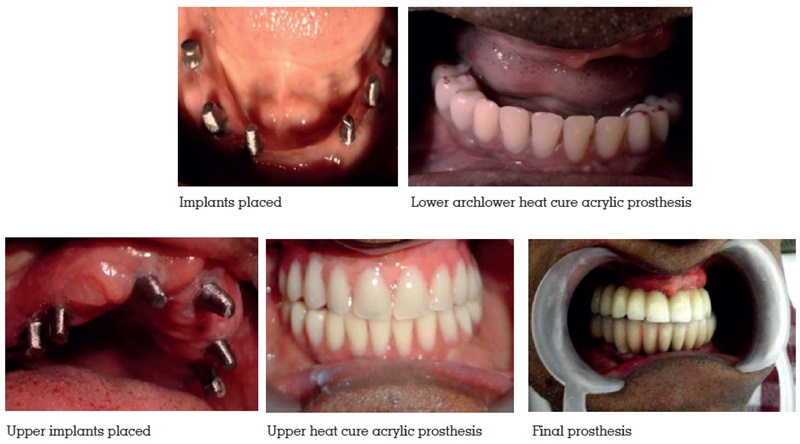

Aim: To evaluate performance of one piece dental implants placed in the edentulous upper and lower arch
Introduction: Over the past two decades,dental implants are one of the commonly used option for the replacement of the missing teeth. Osseointegration being an accepted and well documented concept, attention is now given to simplification of the implant designs and achieving biomechanical success
Case report: This case report describes about the immediate replacement of missing upper and lower teeth with one piece implant system
Conclusion: Unibody design of one piece implant system eliminates the need of a second stage surgery. Single stage one piece implant with immediate loading provides good soft tissue healing and comfort to the patient
Key words: one piece design, immediate loading, single stage surgery, marginal bone loss
Implant placement is the most widely accepted and commonly used treatment for the prosthetic rehabilitation of the missing teeth. The original Branemark protocol consist of a two piece implant system being used in a two stage surgical procedure1. Now a days attention is directed towards simplification of mechanical design, simplifying the procedure and attaining successful osseointegration. The implant –abutment interphase in the conventional TPI, renders the system with a weak line in the entire assembly. The newly introduced one piece implant design (OPI), eliminates the implant abutment interphase and mimic the natural tooth with a seamless transition between the coronal and radicular unit.2
Advantages of using one piece implant design are:
Disadvantages of one piece design are:
An 82 year old male patient reported to the clinic for the fixed replacement of the missing teeth. He was wearing a complete denture which he was not very happy about. He wanted to have his teeth fixed immediately. Patient was explained about the various treatment modalities available. Radiological investigations showed that patient was having good bone quality required for the implant placement.
It was decided to place a total of 12 OPI implants, six on each arch. The implant size selected was 3.7 X 11.5mm (IDEA implant system). Six implants were placed in the lower arch first and abutments were prepared. Bite registration material (JET BITE) was used to record the bite with the prepared lower abutments and the old upper denture, since the vertical dimension of his old denture was found to be satisfactory. Lower impressions were made, Provisional restoration with heat cure resin was fabricated and was luted using conventional cement. Patient was given antibiotics and analgesics prophylactically.
Since the procedure was lengthy, patient was recalled after two days for placing implants in the upper arch. Similar to the lower arch, six implants were placed in the upper arch and heat cure acrylic resin provisional restoration were given in same vertical dimension which was recorded earlier.
Patient was recalled after four months, radiographic evaluation suggested successful osseointegration. Final impressions were made, and a ceramic fpd was fabricated and delivered to the patient in both upper and lower arch.
Success of an implant treatment depend on the survival rate of dental implant, but ongoing marginal bone loss can affect the long term survival of the dental implants. The gold standard for the success of the dental implants as suggested by Alberktson et al describes a marginal bone loss of 1mm during the first year after abutment placement followed by 0. 2mm per year.7
Hahn et al observed that total of 6% of single piece implants had marginal bone loss>2 mm apical to the refence point compared to 16% for two piece implants. One piece dental implants also enables undisturbed healing of the periimplant tissue compared to the two piece design. On the contrary a study conducted by Ostman et al reported that out of 104 one piece implants he examined, 49% had bone loss greater than 2mm compared to 7.7% in two piece design.8
Due to the absence of the connecting screw, it is possible to give a one piece implant of smaller diameter so that it can be used in narrow edentulous areas. One piece implant design with a built in abutment can be prepared with a tungsten carbide bur using the same principles for tooth preparation. Also the impression procedures which are used for one piece implant design is similar to that of a prepared tooth.
A review by Prithviraj et al concluded that most surgeons preferred delayed placements with immediate loading of implants9
Froumet al found no difference between flapless surgeries and traditional flap procedures on single tooth implants with higher survival rates, and stable marginal bone and pocket depths in both the groups.10
Despite these advantages one piece implants also has some disadvantages. After the placement of implant it is not possible to change the abutment angulation. So precise placement of implant is very important. Another disadvantage is the need of immediate loading of implants which can lead to risk of overloading during initial bone healing. Also abutment preparation is very lengthy, as the clinician has to laboriously prepare each abutment.
Literature reveals both positive and negative aspects for placing one piece implants. Long term studies should be done before coming to a solid conclusion. Furthermore selection of each type of implant system depends on each clinical situation and is the discretion of the clinician.